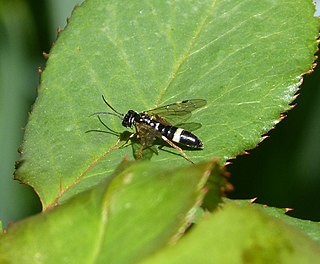
Argidae is a large family of sawflies, containing some 800 species worldwide, primarily in tropical regions. The larvae are phytophagous, and commonly can be found feeding in groups, though very few attain pest status. Notable infestation of this family are recent outbreaks of Shizocera sp. feeding on the leaves of the Mo tree Manglietia conifera (Magnoliaceae) which have occurred in pure stands of the tree in the northern temperate region of Vietnam.

The Blasticotomidae are a very small family of sawflies, containing only 13 species in 3 genera worldwide, restricted to temperate regions of Eurasia where the larvae are specialized stem borers of ferns.

The Pergidae are a moderate-sized family of sawflies occurring in the Western Hemisphere and the Australasian Region. The Pergidae are, with almost 450 described species, the third-largest family of Symphyta after the Tenthredinidae and the Argidae. Morphologically, most pergids are typically sawfly-like, but the form of the antennae varies considerably in number of segments and from simple to serrate and pectinate or even bipectinate. Sexual dimorphism is common and reflected in differences in type of antennae, colour, and size. Included are some of the few known apterous sawflies, those of the genus Cladomacra occurring in Papua New Guinea and Indonesia, and a species with brachypterous females, Clarissa tasbates, in Tasmania.

Arge scapularis or elm argid sawfly is a sawfly in the family Argidae. It is found across North America and commonly infests elm trees. The name "scapularis" refers to the insect's distinctive so-called "shoulder blades".

Arge cyanocrocea, the bramble sawfly, is a species of sawflies of the family Argidae, subfamily Arginae.

Arge ochropus, the rose sawfly, is a species belonging to the family Argidae subfamily Arginae.

Shizocera is a genus of sawflies in the family Argidae.

Arge berberidis, common name berberis sawfly, is a species of sawflies belonging to the family Argidae subfamily Arginae.

Neoptilia is a genus of argid sawflies in the family Argidae. There are at least two described species in Neoptilia.

Arge pectoralis, the birch sawfly, is a species of argid sawfly in the family Argidae.

Arge humeralis, the poison ivy sawfly, is a species of argid sawfly in the family Argidae.

Cimbex americana, the elm sawfly, is a species of sawfly in the family Cimbicidae. This is a very large species of Hymenoptera, with adults measuring 3 cm and larvae reaching 5 cm long. If captured, adults may buzz and use their powerful spiny legs defensively. However, like other sawflies, this species does not possess a sting.
Ametastegia pallipes, the violet sawfly, is a species of common sawfly in the family Tenthredinidae. It is found in Europe.

Ametastegia is a genus of common sawflies in the family Tenthredinidae. There are about 16 described species in Ametastegia.

Ametastegia glabrata, known generally as the dock sawfly or dock false-worm, is a species of common sawfly in the family Tenthredinidae. It is found in Europe.

Allantus cinctus, known generally as the curled rose sawfly or banded rose sawfly, is a species of common sawfly in the family Tenthredinidae. It is found in Europe.
Schizocerella pilicornis,, is a species of argid sawfly in the family Argidae.

Schizocerella is a genus of sawflies in the family Argidae. There are at least two described species in Schizocerella.

Sphacophilus is a genus of sawflies in the family Argidae. There are more than 30 described species in Sphacophilus.

Sterictiphorinae is a subfamily of argid sawflies in the family Argidae. There are more than 20 genera in Sterictiphorinae.

















